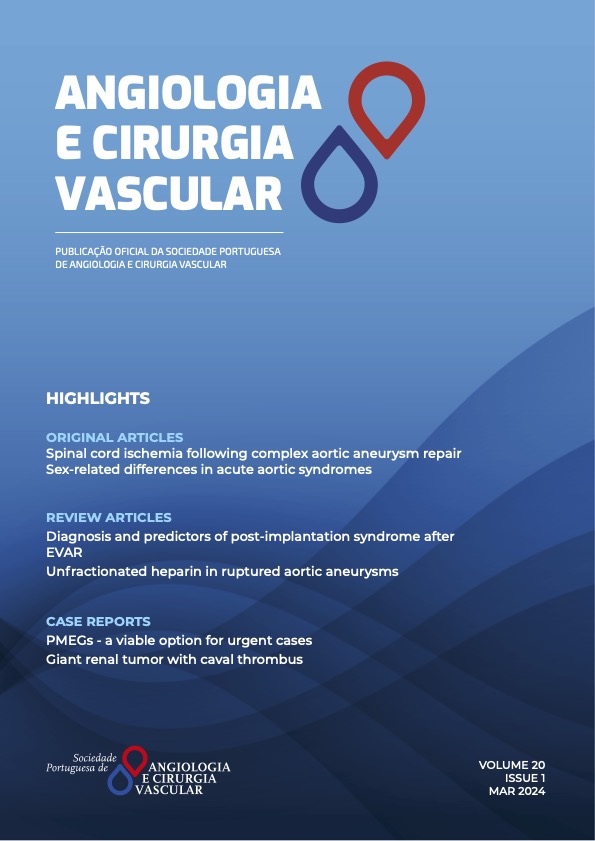Unfractionated heparin in ruptured aortic aneurysms – narrative review
DOI:
https://doi.org/10.48750/acv.564Keywords:
Abdominal Aortic Aneurysms, Unfractionated Heparin, Ruptured Aortic AneurysmsAbstract
INTRODUCTION: Portuguese estimates point out that nearly 20% of aortic aneurysms are treated in a ruptured setting, with in-hospital mortality reaching up to 50%. Although unfractionated heparin (UFH) is routine during elective surgery, this technical point is debatable when treating ruptured aneurysms. The authors aimed to review the literature on the topic of intraoperative heparinization with UFH within the intraoperative period of ruptured aortic aneurysms.METHODS: A MEDLINE and Scopus database search using the terms “unfractionated heparin," “aortic aneurysm," and “ruptured aortic aneurysm” was performed. No time or language limitations were imposed. The last search was run in July 2023. Manuscripts were considered irrespective of study design. Additional articles of scientific interest for the purpose of this non-systematic review were included by cross-referencing.
RESULTS: In the rupture setting, UFH usage rates have widely varied throughout time and geographical sites, and they are reported to be as low as 16%. Overall, the evidence of UFH in clinical practice in this scenario is limited. Notwithstanding, there is some evidence from observational studies of an increased pro-coagulant activity in this clinical scenario, favoring a theoretical physiologic benefit. A prospective, non-randomized study of 131 OSR patients found that patients treated with UFH had improved 30-day survival (84% vs 67%, P=0.001). Non-significant differences in blood product usage were noted. Therefore, societal guideline recommendations about intraoperative UFH in ruptured aortic aneurysms are often missing.
CONCLUSION: UFH may potentially reduce death after open repair of rAAA. These findings should be carefully interpreted, as the evidence is scarce and heterogeneous and only portrays open repair.
Downloads
References
Bastos Gonçalves F, Sousa P, Abreu D, Menezes JD, Mansilha A. Treatment of arterial pathology in the Portuguese Health Service - a report of the years 2009-2017. Angiol Cir Vasc 2021; 17:1-6.
Bastos Goncalves F, Menezes JD, Mansilha A, Vieira M, Sousa J, Quintas A, et al. The first year of the abdominal aortic module of the Portuguese National Registry of Vascular Procedures. Angiol Cir Vasc 2021; 17:72-80.
Dias-Neto M, Castro-Ferreira R, Mani K, Freitas A, Leite-Moreira A, Sampaio SM Nationwide Analysis of Ruptured Abdominal Aortic Aneurysm in Portugal (2000-2015), Eur J Vasc Endovasc Surg 2020; 60:27-35.
Wakefield TW, Lindblad B, Stanley TJ, Nichol BJ, Stanley JC, Bergqvist D et al. Heparin and protamine use in peripheral vascular surgery: a comparison between surgeons of the society for vascular surgery and the european society for vascular surgery. Eur J Vasc Surg 1994; 8:193–8.
Wiersema AM, Vos JA, Bruijninckx CMA, van Delden OM, Reijnen MMP, Vahl A et al. Periprocedural prophylactic antithrombotic strategies in interventional radiology: current practice in the Netherlands and comparison with the United Kingdom. Cardiovasc and Interv Rad 2013; 36:1477–92.
Thompson JF, Mullee MA, Bell PR, Campbell WB, Chant AD, Darke SG, et al. Intraoperative heparinisation, blood loss and myocardial infarction during aortic aneurysm surgery: a Joint Vascular Research Group study. Eur J Vasc Surg 1996; 12:86‐90.
Milne AA, Murphy WG. Current blood transfusion practice in aortic aneurysm surgery in Scotland. The Scottish Vascular Audit Group. J R Coll Surg Edinb 1995; 40:104–8.
Adam DJ, Ludlam CA, Ruckley V, Bradbury AW. Coagulation and fibrinolysis in patients undergoing an operation for ruptured and unruptured infrarenal abdominal aortic aneurysms. J Vasc Surg 1999;30:641–50
Kordzadeh A, Parsa AD, Askari A, Maddison B, Panayiotopoulos YP. Presenting Baseline Coagulation of Infra Renal Ruptured Abdominal Aortic Aneurysm: A Systematic Review and Pooled Analysis. Eur J Vasc Endovasc Surg 2016 51:682-9.
Kornblith LZ, Moore HB, Cohen MJ. Trauma-induced coagulopathy: The past, present, and future. J Thromb Haemost. 2019 Jun;17:852-62.
Mehta M, Byrne J, Darling 3rd JC, Paty P, Roddy SP, Kreienberg PB et al. Endovascular repair of ruptured infrarenal abdominal aortic aneurysm is associated with lower 30-day mortality and better 5-year survival rates than open surgical repair. J Vasc Surg 2013; 57:368-75.
Tottrup M, Fedder AM, Jensen RH, Tottrup A and Laustsen J. The value of routine flexible sigmoidoscopy within 48 hours after surgical repair of ruptured abdominal aortic aneurysms. Ann Vasc Surg 2013; 27:714-8.
Peppelenbosch AG, Windsant V, Jacobs MJ, Tordoir J, Schurink G. Open repair for ruptured abdominal aortic aneurysm and the risk of spinal cord ischemia: Review of the literature and risk-factor analysis. Eur J Vasc Endovasc Surg 2010; 40:589-99
Lammy S, Blakmur JP, Perkins JMT. Intravenous heparin during ruptured abdominal aortic aneurysmal repair. Cochrane Database Syst Rev. 2016;8:CD011486)
Chinien G, Waltham M, Abisi S, Smith A, Taylor P, Burnand KG. Systemic administration of heparin intraoperatively in patients undergoing open repair of leaking abdominal aortic aneurysm may be beneficial and does not cause problems. Vascular 2008;16:189‐93
Zarrintan S, Chow CY, Mathlouthi A, Cajas-Monson LC, Malas M. Use of Heparin during Open Repair of Ruptured Abdominal Aortic Aneurysm is Safe and Reduces Mortality (Abstract). J Am Coll Surg 2022;235: 102-3.
Cuen-Ojeda C, Li B, Tam DY, Dharma C, Feridooni T, Eisenberg N, Roche- Nagle G. The Impact of Heparin on Mortality Following Open Ruptured Abdominal Aortic Aneurysm Repair. Ann Vasc Surg. 2023;96:147-54
Upchurch GR, Escobar GA, Azizzadeh A, Beck AW, Conrad MF, Matsumura JS et al. Society for Vascular Surgery clinical practice guidelines of thoracic endovascular aortic repair for descending thoracic aortic aneurysms. J Vasc Surg 2021;73:55s-83s.
Riambau V, Böckler D, Brunkwall J, Cao P, Chiesa R, Coppi G, et al. Editor's Choice e Management of Descending Thoracic Aorta Diseases Clinical Practice Guidelines of the European Society for Vascular Surgery. Eur J Vasc Endovasc Surg. 2017;53:4–52.
NICE. NG156. Abdominal aortic aneurysm: diagnosis and management. (Available at https://www.nice.org.uk/guidance/ng156).
Wanhainen A, Verzini F, Herzeele IV, Allaire E, Brown M, Cohnert T et al. European Society for Vascular Surgery (ESVS) 2019 Clinical Practice Guidelines on the Management of Abdominal Aorto-iliac Artery Aneurysms. Eur J Vasc Endovasc Surg 2019;57:8-93.









